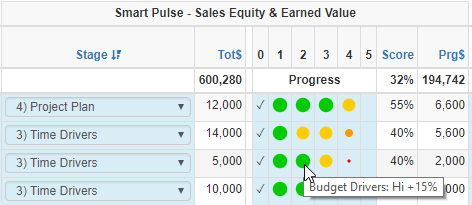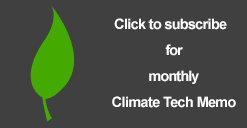Progress Scoring (Part 4) … Scoring System Design

With a “sales process” defined in Part 3, add a progress scoring value to each stage.
If you see a “%” sign here, remember it is % Progress, NOT % Probability.
This avoids the dangers that we discussed in Part 1.
Also, you can have multiple levels of value for each stage, so “Partial Progress” can be scored.
Here is a simple example. Use this as a starter for setting up your own Progress Scoring system:
Stage 0 – Qualified – No or Yes – Score max 5% progress when Yes, 0% when No.
Stages 1, 2, 3, 4 – Purpose/ Payback/ Time Drivers/ Proposal – and identify sub-stages for tangible evaluation of Progress:
- Score max 15% for each Stage
- Sub-stages could be: Off 0%/ Discussed 5%/ Written 10%/ Co-authored 15%
Stage 5 – Verbal order? – No or Yes – Score max 15% when Yes
Stage 6 – Closed and Won – Score the balance. My recommendation is to always leave 20% or more left available for this transition to a written purchase order. Surprises will happen, and every Deal/Opportunity has its risks.
The Opportunity list – where Progress within Process drives Progress Scoring
With a Sales Process designed, and a scoring plan to keep track of earned value on each opportunity, set up a Deal list table to roll up the numbers. As simple as this sounds, it takes a computer app to keep track of these numbers, and present useful reports. Discipline, cadence and regular management reviews will help you see the trends. Here are some examples of the need for disciplined recording of progress:
- Keeping the sales team honest about whether the completion of a stage was in writing to the buyer(s)
- Staying open to the fact that these things do not have to proceed in series – there are multiple things happening in parallel in our B2B universe, and the customer preferences will often drive the sequence of stage accomplishment
- Score down-grading is a real possibility (e.g. if your champion leaves the customer business, or a demo/prototype/trial fails to deliver). Use management judgement to take the Deal back a few notches on the Progress score
On the computer side, we have done this before with spreadsheets and CRM systems, and found them to be awkward or incomplete for sales process design. Hence a process and scoring system is better designed in a Sales Automation system.
Scoring in SmartFunnel 2.0 as example – and Figures-of-Merit trending
SmartFunnel 2.0 provides a scoring system that lets you quickly implement the above process. It also allows tailored Sales Processes for several different Deal Types (for different Product Lines). It also lets you break your key selling elements (Stages) down into three levels of depth as “sub-stages”. Use the sub-stages metric in a simple way such as:
- “Lo” = Talked – Topic discussed with customer, and there is interest to proceed further
- “Med” = Written – Topic written and send to customer for comment /confirmation
- “Hi” = Engaged – Topic has received customer response and correction/collaboration
So, for each stage 1/3 of the score is allocated for each level of increased depth of engagement.

Both score (in %) and the weighted Deal value (Prog$) are shown for each Deal line item, beside the colored visual progress indicators.
A “mouse-over” on the stage progress indicator reveals a pop-up summary of your company’s descriptor – and score % for your advances within that stage.
The net effect is a score that allows you to gain new insights:
- The header line Score % (e.g. 32% for the overall funnel) is a good figure-of-merit for the advances being created by the sales team – trending up is a good sign, and trending down should only happen when new opportunities have been added, or a Deal has been closed
- The weighted value sum (“Prg $”), for the total funnel, is a good proxy for forecasting sales bookings over a certain period – this is a leading indicator
- On each Deal line item the Score, combined with visible stage progress, guides you to the next sales action – and guides the Sales Manager to coaching actions with the team
This workflow is implemented in SmartFunnel 2.0 in a way that is easy to customize, enabling multiple different Opportunity Types, to suit each of your product lines. In addition, as compared to CRM systems, SmartFunnel enriches sales coaching, by enabling frequent refinements of your process and scoring systems. And more good news, you can do that without the tedium and delays of CRM re-programming.



Follow Us
Follow us on LinkedIn for updates.